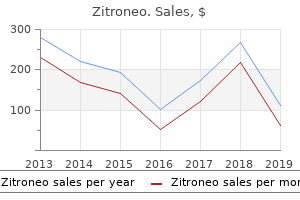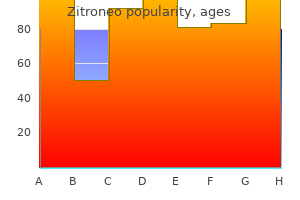

 5100 Springfield St. Suite 108, Dayton, Ohio 45431-1274
5100 Springfield St. Suite 108, Dayton, Ohio 45431-1274Zitroneo
"Order zitroneo toronto, infection 3 months after wisdom teeth extraction".
By: H. Georg, M.B. B.A.O., M.B.B.Ch., Ph.D.
Co-Director, Cooper Medical School of Rowan University
Children should be supervised by their parents or a responsible adult during the entire visit antibiotics for uti during first trimester order zitroneo with american express. Adapted from the American Academy of Pediatrics Committee on the Fetus and Newborn: Postpartum (neonatal) sibling visitation antibiotics for uti flucloxacillin discount 100 mg zitroneo visa, Pediatrics 76:650 antibiotics to treat diverticulitis generic 500 mg zitroneo fast delivery, 1985. Standard precautions should be used with all patient contact regardless of the underlying diagnosis or infectious status. These precautions consist of universal precautions (designed to prevent blood and body fluid contamination) and body substance precautions (designed to prevent contamination with moist substances). Transmission-based precautions are necessary when a patient is infected with a known or suspected pathogen that is associated with a high risk of contamination via airborne or droplet transmission or contact with the skin or contaminated surfaces (Garner, 1996). Gowns should be used in specific circumstances in which the risk for contamination is high or the infant is being held. Various regulatory agencies have developed guidelines for sibling visitation (Box 40-4) (American Academy of Pediatrics, 1985). Infection and colonization rates have not risen with use of the current standards. But the challenge that faces neonatologists, nurses, respiratory therapists, physical therapists, clerks, environmental service staff, and anyone else who affects the care of the neonate now must be framed by the following question: can we get to zero Much is known about the mechanisms of catheter-related infections and the factors that increase risk. Effective prevention strategies focus on modifying the known risks, such as standardization of procedures that relate to central line care, strategic nursery design, adequate staffing, hand-washing compliance, minimization of catheter days, and promotion of enteral nutrition, especially with human milk (Adams-Chapman and Stoll, 2002; Goldmann, 1989; Horbar et al, 2001). Care "bundles" incorporating a group of interventions aimed at standardizing central line care can be effective if a particular intensive care unit is committed to implementing them. One hundred percent compliance with adequate hand hygiene is required to eliminate the spread of viruses and bacteria, particularly those that are drug resistant. Historically, the benefits of hand washing have been known since the early nineteenth century. Labarraque, a French pharmacist, was one of the first to demonstrate that cleansing the hands with solutions containing lime or soda could be used as disinfectants and antiseptics (Boyce et al, 2002). The issue was further elucidated by Ignaz Semmelweis in the 1850s, who noted that the mortality and puerperal infection rates were higher among women receiving care from physicians than in those receiving care from midwives. He postulated that the puerperal fever in these patients was caused by "cadaverous particles" transmitted from the autopsy suite on the hands of the students and physicians. This intervention represents the first clinical evidence suggesting that cleansing contaminated hands with an antiseptic agent was more effective than washing them with plain soap and water and that hand antisepsis could reduce the spread of contagious disease via the hands of health care workers (Boyce et al, 2002). Each manufacturer has guidelines for the volume to be used; in general, enough should be applied so that it takes 15 to 25 seconds to dry. Foot pedals, automatic faucets, or towel barriers should be used to turn off the water. Guidelines for Hand Hygiene Practices in the Neonatal Intensive Care Unit Clinical Indications for Hand Hygiene Hand hygiene techniques are effective in decreasing the colonization rate of resident and transient flora and have been shown to reduce cross-contamination among patients. Several studies have shown that the hands of health care workers become contaminated during routine patient care activities, including "clean" procedures such as lifting patients and checking vital signs, as well as during contact with intact skin (Casewell and Phillips, 1977; Pittet et al, 1999). Attempts have been made to stratify the type of activity with the likelihood of contamination, but they have not been validated by quantitative bacterial contamination analysis. Direct patient contact and respiratory tract care seem to be particularly associated with contamination (Pittet et al, 1999). Recommendations concerning indications and techniques for hand hygiene are summarized in Box 40-6 (Boyce et al, 2002; Garner and Favero, 1986; Larson, 1995).


Either the person performing the echocardiogram or another assigned person should monitor heart rate antimicrobial vinyl purchase zitroneo australia, blood pressure antibiotics simplified pdf zitroneo 100mg fast delivery, and ventilatory parameters during the procedure in unstable antibiotic resistance mortality order zitroneo canada, ill infants. The ultimate goal of fetal echocardiography is the accurate definition of any anatomic abnormality of the heart during the prenatal time period. Currently, however, a comprehensive cardiovascular evaluation is recommended only in those with identified risk factors. The components of a comprehensive evaluation are listed in Table 53-2, although not all may be visualized in every fetus at every examination. Once a diagnosis is established, the secondary goal of fetal echocardiography, parental counseling, can begin. Prenatal management plans need to be discussed, including local laws regarding termination of a pregnancy. Finally, perinatal management plans can be created to smooth the transition to the postnatal time period. In addition, noninvasive cardiac imaging provides diagnostic support for the management of a variety of neonatal conditions. The indications for the performance of an echocardiogram in the nursery or newborn intensive care unit include the assessment of the neonate with a presumed syndromic or genetic condition that is at high risk for cardiac disease. The goals of neonatal cardiac imaging are similar to that of the fetal echocardiogram. Cardiac and abdominal situs are assessed, a complete evaluation is made of the anatomic structure of the heart and proximal vasculature, and a determination is made as to the functional (systolic and diastolic) properties of the myocardium. For an accurate determination to be made as to the dimensions of chambers, valves, and vessels, a normative data set is required. The most common methodology involves normalizing measurements to body surface area. A number of data sets are available for comparison; in order to achieve consistency, each pediatric echocardiography laboratory must decide which of these data sets will be used. The identification of a pathologically large or small structure is especially troublesome when the patient is markedly premature. Comparative data for such children are scant and are often based on data collected from a very small number of "normal" patients. Serial echocardiographic evaluations are often necessary in order to care for the neonate. We follow left atrial and left ventricular chamber dimensions as pulmonary vascular resistance drops in order to determine the left-to-right shunt impact in the face of a patent ductus arteriosus. We follow interventricular thickness and left ventricular outflow tract obstruction in the infant of a diabetic mother to determine if serial improvement occurs over time. The neonatal cardiopulmonary system is a highly fluid system, subject to perturbation from numerous outside influences and thus requires close monitoring in the labile child. Echocardiography is but one tool in the armamentarium of the neonatologist and cardiologist to assist with this monitoring. Additionally, pulsed- and continuous-wave Doppler can be used to establish flow velocity and predict the pressure difference between the aorta and pulmonary artery. In addition, the determination of aortic arch sidedness or branching pattern is important should surgical ligation be required (Murdison et al, 1990). Typically the aortic arch is a left aortic arch with a left-sided ductus, but a right aortic arch with a right-sided ductus can occur and alters the surgical approach to ductal ligation.

Thus antibiotics for acne cysts discount zitroneo online amex, in preterm infants during the first postnatal day infection tattoo generic 500mg zitroneo free shipping, blood pressure may be low because resistance is low in the presence of normal or high blood flow antimicrobial shampoo human buy genuine zitroneo on-line. Alternatively, blood pressure may be normal or high because resistance is high in the presence of normal or low blood flow (Evans and Kluckow, 1996, 2000). The uncertainty surrounding the nature of the relationship between blood pressure and systemic blood flow during the transitional period results from our inability to appropriately define the normal blood pressure range (Engle, 2008) and systemic blood flow (see earlier), and to characterize the developmental regulation of organ blood flow and vital organ assignment (see later discussion) in the preterm neonate. However, the autoregulatory blood pressure range in this patient population is believed to be narrow, and the "normal" blood pressure is very close to the lower elbow of the autoregulatory curve (Greisen, 2005, 2008). Organ blood flow autoregulation is impaired in preterm neonates who are more immature and sicker (McLean et al, 2008; Tsuji et al, 2000; Wong et al, 2008). However, the finding that impaired autoregulation may also be a consequence of a preceding ischemic insult (Greisen, 2008) makes clarification of this question particularly difficult. The vessels of the vital organs respond to decreased perfusion pressure and/or oxygen delivery with vasodilation. Several lines of evidence in human neonates and developing animals suggest that the assignment of the forebrain circulation to a high-priority vascular bed may not be complete at birth (Ashwal et al, 1984; Hernandez et al, 1982; Victor et al, 2006b). For instance, the vessels of the forebrain of dog pups vasoconstrict like those of a nonvital organ whereas the vessels of the hindbrain vasodilate in response to hypoxic exposure (Hernandez et al, 1982). The cellular mechanisms responsible for the assignment of vital and nonvital organ status from a blood flow regulatory standpoint are poorly understood. Based on these findings, it is tempting to speculate that the diminished capacity of the forebrain vessels to vasodilate in the very preterm neonate during the complex process of cardiovascular transition after delivery may contribute to hypoperfusion of the forebrain. These neonates may present with blood pressure values in the perceived normal range while being in the compensated phase of shock. Because this early phase of shock is difficult to recognize immediately after delivery, forebrain hypoperfusion and, on adaptation to the extrauterine environment, the ensuing reperfusion can go unnoticed. This proposed vital organ assignment-associated reperfusion cycle might contribute to cerebral injury in the very preterm neonate (Noori et al, 2009). To summarize the pathogenesis of the abnormal circulatory adaptation in the very preterm neonate, there is indirect evidence that the sudden increase in systemic vascular resistance after separation from the placenta combined with myocardial immaturity plays a role in the development of the low flow state (Kluckow and Evans, 2000b). Because the preterm myocardium is adapted to a low-resistance intrauterine environment, characterized by reduced contractile elements, and has a limited ability to respond to increased afterload (Hawkins et al, 1989; Takahashi et al, 1997), it likely struggles to cope with the sudden increase in vascular resistance immediately after birth. This is compounded by shunts out of the systemic circulation through the fetal channels and the negative circulatory effects of positive pressure ventilation. In addition, the vessels of the forebrain initially vasoconstrict as the compensated phase of shock develops. As the final outcome of these hemodynamic events, critically low systemic and forebrain blood flow develops in many of these patients even with blood pressure values in the suspected normal range. Then, as treatment, endocrine, neuroendocrine and other compensatory responses to stress are initiated, the cardiovascular system adapts, and systemic blood flow improves, with reperfusion of the organs including the forebrain. However, if the low flow state is severe, a reperfusion injury may occur during the period of cardiovascular stabilization, especially in the extremely vulnerable immature central nervous system. Thus, hemodynamic compensation of shock in the very preterm neonate during the immediate postnatal period may not protect against central nervous system injury. Finally, patients in the uncompensated phase of shock with recognized circulatory compromise face the very same hemodynamic scenario, as by definition reperfusion of all organs including the brain will take place. Yet, several lines of evidence indicate that the very preterm neonate is unable to couple cerebral oxygen demand with blood flow, and instead increases oxygen extraction when oxygen demand is increased (Victor et al, 2006a, 2006b). This phenomenon may be linked to the developmental delay in the vital organ assignment of the forebrain immediately after delivery (see earlier discussion).
Best order zitroneo. Antimicrobial Efficacy Testing | Estudio de eficacia antimicrobiana.

